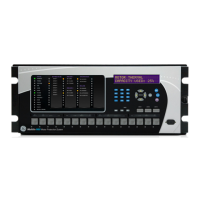5-198 M60 MOTOR PROTECTION SYSTEM – INSTRUCTION MANUAL
GROUPED ELEMENTS CHAPTER 5: SETTINGS
5
IEC CURVE k FACTOR — This setting applies only to the IEC motor curve and is applied as described in the THERMAL MODEL
CURVE
setting description. See the IEC 255-8 standard for details on its application.
IEC CURVE TIME CONSTANT — This setting specifies the thermal time constant for IEC motor curves in the previous equations
per the IEC 255-8 standard. When the IEC motor curves are selected, the M60 calculates the time to trip using the IEC255-
8 cold curve and IEC255-8 hot curve equations and increases thermal capacity used as defined by the thermal capacity
used equation earlier. If the overload disappears or the motor is tripped (stopped), then the thermal capacity used
decreases as per the following equations to simulate motor cooling, depending on the motor status and the values
programmed for the
COOL TIME CONSTANT RUNNING and COOL TIME CONSTANT STOPPED settings.
If the IEC curve is selected, then the following applies:
• For two-speed motor applications, the
IEC CURVE k FACTOR and IEC CURVE TIME CONSTANT settings are used at both
speeds
• Voltage dependent overload curves are not applicable
• The motor status is evaluated using motor FLA (I
b
) and the IEC CURVE k FACTOR setting
THERMAL MODEL TD MULTIPLIER — This multiplier is used to shift the overload curve on the time axis to create a family of the
different curves. The TD multiplier value is used to select the curve that best matches the thermal characteristics of the
protected motor.
If thermal model curve is selected as “Motor,” then the
THERMAL MODEL TD MULTIPLIER can be specified between “1.00” and
“15.00” as indicated in the following Standard Motor Curves diagram.

